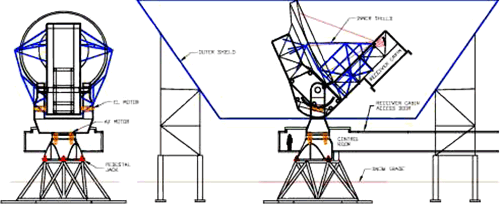By far one of the most impressive structures here at the south pole is the South Pole Telescope. This gigantic microwave telescope is housed in the Dark Sector Laboratory, and features the iconic satellite dish extending out the roof. Over the course of the Summer 2012-2013 south pole season, I’ve had the opportunity to spend a bit of time over at the telescope.
A brief overview of the SPT, from the University of Chicago:
The South Pole Telescope is a 10 meter diameter telescope operating at the NSF South Pole research station. The telescope is designed for conducting large-area millimeter and sub-millimeter wave surveys of faint, low contrast emission, as required to map primary and secondary anisotropies in the cosmic microwave background. The SPT is a collaboration between the U of Chicago, UC Berkley, Case Western Reserve University, U of Illinois, and Smithsonian Astrophysical Observatory, and is primarily funded through NSF OPP.
Why is this telescope specifically at the south pole?
Ground based astronomical observations at mm and sub-mm wavelengths place extreme requirements on the transmission and stability of the atmosphere. Steady atmospheric emission loads the bolometric detectors and adds photon noise, reducing overall sensitivity. Fluctuations in atmospheric brightness add noise to the detector timestream data as well. For these reasons high altitude sites, preferably with stable atmospheric conditions, are needed for ground based observations such as those targeted by the SPT.
Emission from the atmosphere consists of two components, one due to “dry air” which results from the wings of oxygen lines and a second component due to water vapor. The “dry air” component is well-mixed in the atmosphere and produces a signal that is only a function of elevation, commonly removed by beam switching. Water vapor, on the other hand, exhibits considerable variations in its density. These fluctuations in water vapor density result in spatial variations in the brightness of the sky.
A few pics from throughout the season:
The Dark Sector Laboratory building, a 15 minute walk away from the south pole station.

Inside the telescope mount – here’s a shot of the spiral of control cables and hoses at the heart of the telescope support.

Scientist Amy Bender at the base of the telescope.

For servicing, the telescope can be “docked” to the roof of the DSL building. Once docked, the roof of the building opens, revealing the access hatch to the telescope’s sensor. In this picture you can see the empty sensor box, as the sensor is being worked on.

The main sensor cryostat – it loves clusters of galaxies.

And finally, a direct shot of the telescope dish, as seen from the groundshield of the KECK Array.



Comments
2 responses to “Exploring the South Pole Telescope”
[…] South Pole Telescope […]
[…] Jeffery Donenfeld explains that in